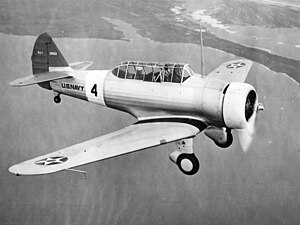North American BT-14
| BT-9/BT-14/NJ | |
|---|---|
 |
|
| A U.S. Navy NJ-1 in flight, 1938 | |
| Role | Trainer |
| Manufacturer | North American Aviation |
| First flight | April 1936 |
| Primary users |
United States Army Air Corps United States Navy |
| Number built | +260 |
| Unit cost |
$20,000 USD
|
| Developed from | North American NA-16 |
| Developed into | North American BC-1 |
The North American BT-9 was the United States Army Air Corps (USAAC) designation for a low-wing single piston engine monoplane primary trainer aircraft that served before and during World War II. It was a contemporary of the Kaydet biplane trainer and was used by pilots in Basic Flying Training following their completion of Primary in the Kaydet. The NJ-1, which was similar to the one off BT-10, was used by the United States Navy.
The BT-9, designated NA-19 by the manufacturer, evolved from the North American NA-16, which first flew in April 1935. The BT-9 design first flew in April 1936.
The wing and tail control surfaces were fabric-covered, as well as the sides of the fuselage from just behind the firewall to the tail. The remainder of the aircraft was metal-covered and featured fixed (non-retractable) landing gear. The Army Air Corps purchased a total of 199 BT-9s, BT-9As and BT-9Bs. Many foreign countries also used variants of this aircraft under North American's NA-16 designation.
The first BT-9C s/n 37-383 was built with a 600 hp Pratt & Whitney R-1340-41, but was otherwise similar to the normal BT-9Cs. It was delivered as the Y1BT-10, and later redesignated BT-10.
The BT-9D was a one off prototype that tested out a number of ideas that went into production as the BT-14 (NA-58), which the similar North American NA-64 Yale represented a major aerodynamic improvement over the NA-16 series, with a longer all-metal fuselage replacing the fabric covered fuselage of the earlier NA-16s. The BT-14 featured a Pratt & Whitney R-985 engine versus the Wright R-975 used on the BT-9. As well as metal skin replacing the fabric on the fuselage, the fin was moved aft slightly, lengthening the rear fuselage while the engine was moved forward to maintain the center of gravity. The rudder was also changed from the rounded shape used previously to one with a roughly triangular shape, with the broadest part being at the bottom, and the canopy was redesigned. The new fuselage would provide the basis for the entire AT-6 family, when fitted with the larger Pratt & Whitney R-1340 engine, a new wing with retractable undercarriage and minor changes for a gunners position.
...
Wikipedia
